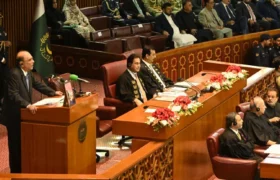Pakistan is among top 10 countries faced with water scarcity challenge. Usually, KPK was considered water abundant province but due to lack of planning and management of available resources, situation has turned alarming particularly in context of drinking freshwater availability. Due to unsustainable water extraction from ground via tube wells for agricultural uses, underground water tables have receded, and now it’s very difficult to extract that water. Erratic and insufficient rain water is also a contributing factor in this glaring crisis in the province.
It’s notice worthy that despite the fact that the province suffers flooding almost every year at smaller scale and regularly witness a large-scale flooding once in a decade, water scarcity is not only prevailing but increasing by every year. This is the outcome of poor planning, insufficient data collection and mismanagement of resources. Pakistan generally failed to build large scale water reservoirs, which were to build to sustain agricultural and economic growth amid growing population. The situation in KPK is no different. Despite the fact that hundreds of small dams and run-of-river electricity generating units were built, but there was / is no plans in sight regarding building large scale water reservoirs to cater agricultural uses so that dependence on groundwater can be reduced. New water reservoirs were required for flood management as well. For example, had there been a large dam on Kabul and Swat rivers, the province could have seen less devastation in last year’s historic floods. Unfortunately, political ambitions and lack of advanced threat assessment led to the present situation. Consequently, the province is faced with severe conditions of water scarcity on one hand while trying to cope with devastation caused by climate changes on the other.
Only last year, provincial government paid attention to this deficiency of large reservoirs and initiated around 70 dams out of which 5 are large ones. Officials are hopeful that these dams will play a role in raising the water table in the province, however the fact remains that their completion will take many years. Nevertheless, these projects are a welcome move by provincial government that will play a critical role in combating the water crisis in the province.
This water scarcity is nothing new in the province. In 2014, the provincial government declared five districts out of 34 – Dir Lower, Dera Ismail Khan, Karak, Lakki Marwat and Tank – as hotspots of drinking water scarcity. Four of these were in the south of the province. These southern parts of the province are the areas where agriculture is a major source of income for millions of people. The situation has only worsened during the last 8 years, as official data shows a dangerous amplification of this crisis. Last year, Ministry of Water Resources submitted official data to the Senate by the reveal that groundwater in 28 districts of K-P is rapidly declining, out of which the level in 5 districts is dangerously low – in the last decade the groundwater level has dropped by 25 to 74 feet.
Water crisis is not limited to southern districts only. Areas like Bajur and Swat are also among hit by this calamity. In November 2022, it was reported that Islam Ghut, a small village of around 1100 people in Bajur district, was adversely hit by drinking water shortage. Locals had to fetch fresh water from as far as 5 kilometers away. Similarly, last year local administration of Swat had to issue notices to people appealing them to reduce the usage of water.
Water crisis in KPK is ensuing crisis with far-reaching implications both in social and economic contexts. It’s high time for all the stakeholders to come together and raise above the political and ethnic divides to find lasting solutions for such crises. The federal government also bears great responsibility in this regard. It must pay all the royalties and other funds to KPK government to ensure sustained development of water preservation infrastructure and facilities in the province.




